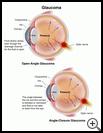
Glaucoma
________________________________________________________________________
KEY POINTS
- Glaucoma is an eye disease that damages the nerve that carries messages from the eye to the brain. This is usually caused by high pressure inside the eye. The fluid in the front of the eye is constantly flowing from where it is formed into drainage channels, and is then reabsorbed by the body.
- In open-angle glaucoma, fluid drains slowly, causing the pressure in the eye to increase. In angle-closure glaucoma, fluid is not able to drain from the eye.
- The goal of treatment is to reduce the pressure in your eyes and decrease damage to the optic nerve. This may be done with eye drops, pills, laser surgery, or other types of surgery. Some of these treatments reduce the amount of fluid your eyes make. Other treatments make fluid drain from the eye better.
________________________________________________________________________
What is glaucoma?
Glaucoma is an eye disease that damages the nerve that carries visual messages to the brain (optic nerve). This is usually caused by high pressure inside the eye. Damage to the optic nerve can cause a permanent loss of vision. Glaucoma needs to be diagnosed and treated early to prevent blindness.
Normally, the fluid in the front of the eye is constantly flowing from where it is formed (the ciliary body) to the front of the eye. This fluid nourishes your eye and helps to keep its shape. The area between the iris (colored part of the eye) and the cornea (the clear outer layer on the front of the eye) is called the angle. Fluid drains out through the angle, into drainage channels, and is then reabsorbed by the body. When fluid flows out too slowly, eye pressure builds up.
What is the cause?
There are 2 main types of glaucoma.
In open-angle glaucoma, fluid drains slowly, causing the pressure in the eye to increase. This happens even though the drainage channel for the fluid appears to be open. One type of open-angle glaucoma is caused by injury to the eye. In most cases of open angle glaucoma, it is not known what causes the fluid to drain out too slowly.
In angle-closure glaucoma, the angle between the iris and the cornea is blocked or narrowed. When this happens, fluid is not able to drain from the eye. This can cause a pressure buildup. This can happen if the pupil is dilated too much, causing the iris to "bunch up," or if the lens ”crowds” the iris and causes it to bend forward and close the angle. When this type of glaucoma happens suddenly, it is called acute angle-closure and is a medical emergency.
Glaucoma tends to run in families and is more common in people over age 60.
What are the symptoms?
Open-angle and other forms of glaucoma typically happen gradually and often have no symptoms in the early stages. In later stages, you will begin to notice a loss of vision, starting with your side vision.
Symptoms of acute angle-closure may include:
- Severe eye pain
- Seeing halos around lights
- Nausea and vomiting
- Headache
- Loss of vision
How is it diagnosed?
Your eye care provider may:
- Measure the pressure in your eyes and the thickness of your cornea
- Check for changes in your side vision caused by damage to the optic nerve
- Look at the optic nerve inside your eye
- Examine the drainage channels with a special mirrored lens
How is it treated?
The goal of treatment is to reduce the pressure in your eyes and decrease damage to the optic nerve. This may be done with eye drops, pills, laser surgery, or other types of surgery. Some of these treatments reduce the amount of fluid your eyes make. Other treatments make fluid drain from the eye better.
If your healthcare provider prescribes medicine to control the pressure, you may need to take it for the rest of your life.
Smoking marijuana is NOT an effective treatment for glaucoma.
How can I take care of myself?
- Carefully follow your healthcare provider's instructions for follow-up exams.
- Use your medicine as directed. If it is hard for you to use the medicine correctly, let your provider know. Other treatments may work better for you.
- See your eye care provider right away if you notice any changes in your vision.
How can I help prevent glaucoma?
Glaucoma cannot be prevented. However, blindness can be prevented if glaucoma is treated before pressure in the eye has damaged the optic nerve too much. Learn about your family history. Chronic open-angle glaucoma often runs in families.
You may be able to help prevent glaucoma from becoming severe if you have eye exams as often as your eye care provider recommends. The exams should include measuring the pressure in your eye and examining your optic nerve and visual field.

